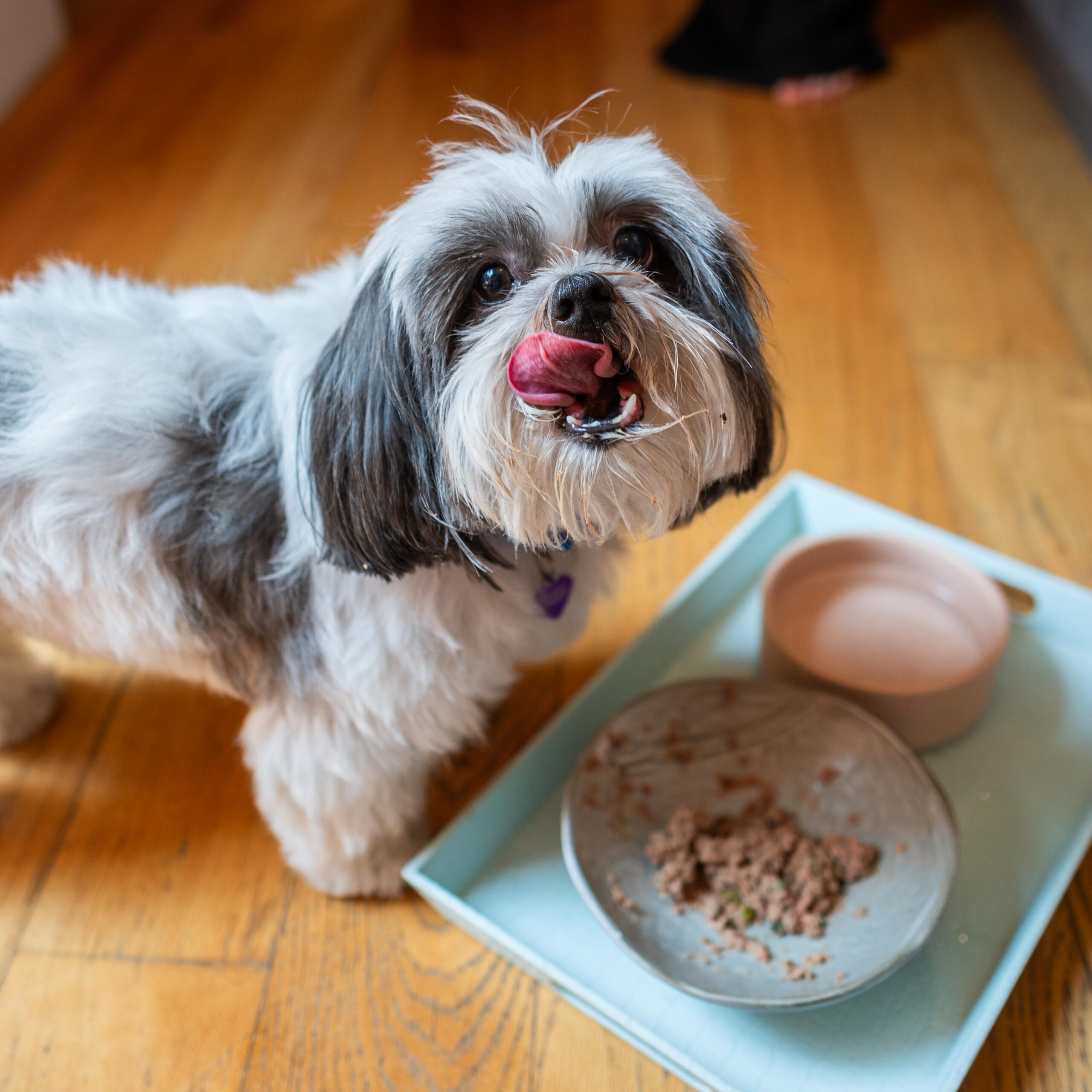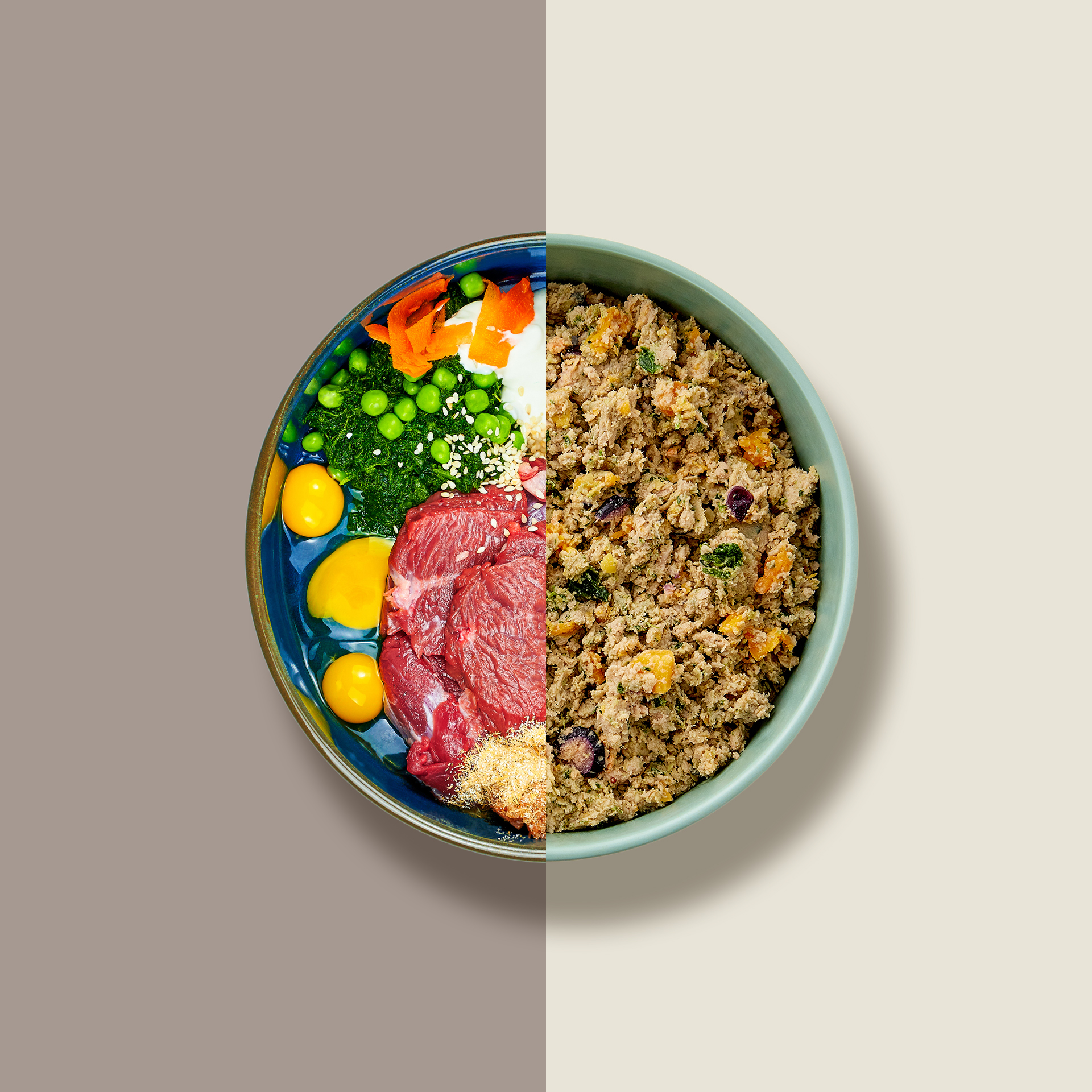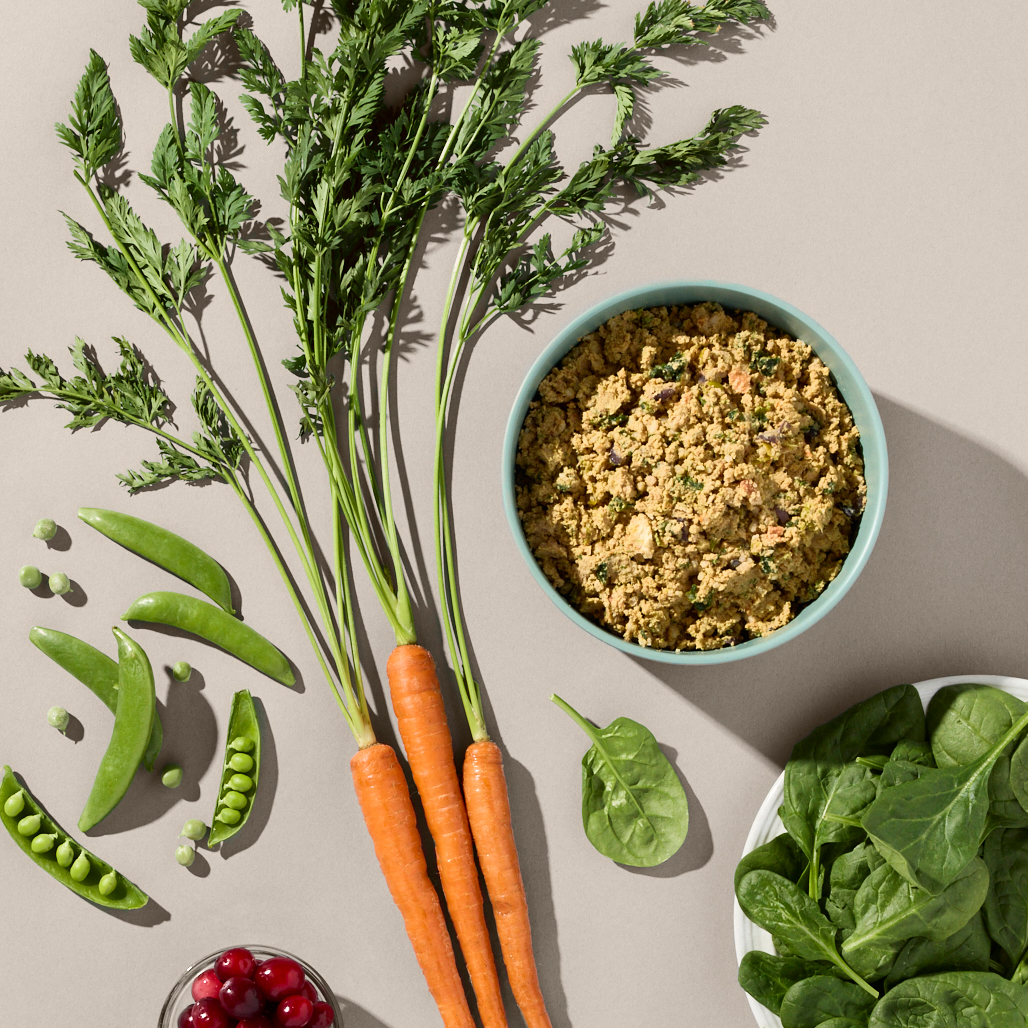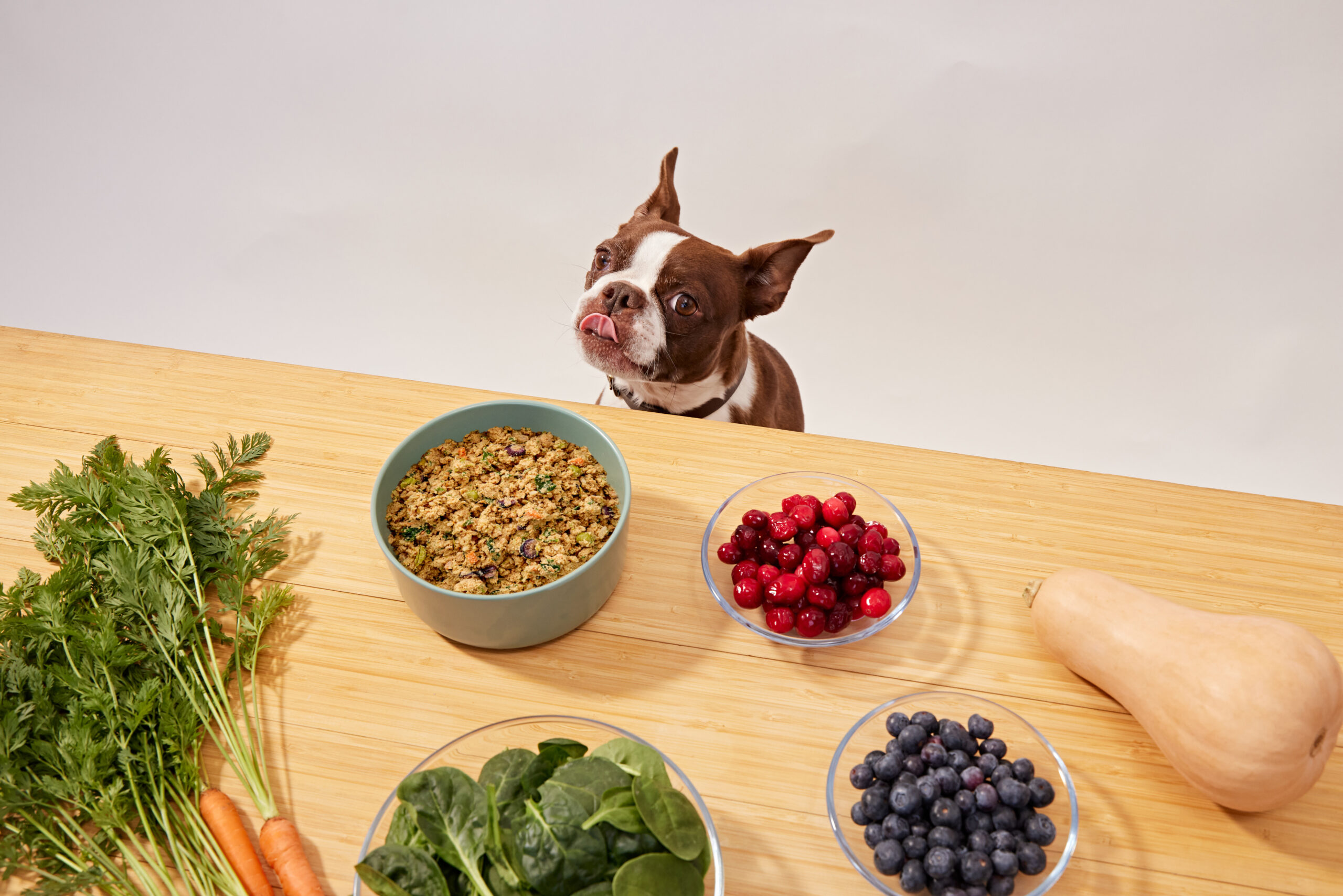Hey Ollie blog readers! We’re offering you an exclusive 60% OFF your starter box! Try now!
Proper nutrition is fundamental to your dog’s long-term health and wellness. But with so many different dog food formulations claiming to provide the best canine diet, many pup parents like you are left wondering which type truly stands out from the pack.
Let’s take a look at four of the most popular dog food formulations, weigh their pros and cons, and see which is best suited for your pup’s unique needs, health, and lifestyle.
Fresh Dog Food
Fresh dog food is made with lightly-cooked fresh whole ingredients such as animal proteins, fruits, vegetables, and hearty grains and without filler ingredients or preservatives, fresh dog food delivers highly palatable and nutritious meals without the hassle—and risk—of home-cooking for your dog.
To preserve freshness, flavor, and quality, fresh dog food is always refrigerated or frozen and packaged in small portions. At Ollie, your pup’s meal plan is entirely customizable, ensuring they receive their favorite recipes in ready-to-serve portions tailored to suit their nutritional needs.
Benefits of Fresh Dog Food
- Enhanced digestibility — Simple, natural ingredients promote natural healthy digestion.
- Customized meal plans — Adust your pup’s plan at any time.
- High-quality ingredients — Responsibly sourced whole food ingredients you can see in your pup’s bow—land in their improved health and energy.
- Ingredient and preparation transparency — The secret to success is not needing to keep secrets about where our ingredients come from or how they’re prepared.
- Numerous potential health benefits — Research on fresh dog food is increasing, and so are its benefits. Fresh food can help pups maintain a healthy weight, experience better digestion, learn faster, and may help prevent certain medical conditions.
Dry Dog Food
Dry food or dog kibble is the most popular formulation, merging complete and balanced nutrition with convenience and affordability. Dry food generally combines meat or meat meal, grains, vegetables, fruits, and supplemental vitamins and minerals to create a reliably nutritious and easy-to-serve food. Through a process called extrusion, dry dog food ingredients are ground, cooked at high heat, forced through a die that gives kibble its signature shape, and baked until completely dry. Unfortunately, through this intense cooking process, nutrition, moisture, flavor, and digestibility are often reduced.
10 Healthy Foods to Add to Your Dog’s Kibble
Dry Dog Food Benefits
Despite the potential compromise in nutritional quality, dry dog food does offer benefits such as:
- Long shelf life — Kibble’s shelf-stable nature and added preservatives make it an economical option, especially for multi-dog households.
- Cost-effective — Dry dog food is generally the most affordable dog food formula and can be easily purchased in bulk.
- Better for grazers — Unlike other dog food formulas, dry food won’t spoil if it’s left in your pup’s bowl.
- Easy to measure — Kibble’s consistent size and shape make it easy for pup owners to feel confident about meal portions.
- Dental benefits — Specifically-designed dental diets can help remove plaque and tartar from your pup’s teeth as they chew.
Wet Dog Food
Wet or canned dog food is a soft diet made with animal meat, vegetables, and grains, and balanced with essential vitamins and minerals. Food texture can vary from a fine mince to chunked or stew-like formulas to suit every pup’s preference. The final product is sealed in air-tight cans to lock in freshness and prevent spoilage. Canned food is favored for its high palatability and generally contains more meat and fewer carbohydrates than kibble, as well as no synthetic preservatives. However, because of its packaging style, wet food tends to be more expensive than dry food.
Wet Dog Food Benefits
Advantages of wet food include:
- Easy consumption — Soft wet food is easier to serve to sick or recovering pets as it can be made into a slurry and fed via a syringe. Many senior dogs with dental problems also find soft foods easier to pick up and consume.
- Enticing flavor and aroma appeal to picky pups — Dogs with a decreased appetite can often be persuaded with wet food, served whole or as a topper to their regular diet.
- High moisture content improves health — Unlike dry food, wet food contains natural moisture which can help pups stay hydrated. This is especially advantageous for dogs with urinary issues.
- Easy to portion and serve — Wet food can be easily measured on a gram scale to ensure consistent portion size and caloric intake.
How Much Wet Food Should You Be Feeding Your Dog?
Raw Dog Food
Raw dog food diets are considered biologically appropriate because of the dog’s ancestral behavior and anatomical features that persist to this day—namely the sharp pointed teeth and short digestive tract of a meat eater. Raw dog food models or methods include the BARF (i.e., biologically appropriate raw food) diet or PMR (i.e., prey model raw) diet. Both feature raw meat and uncooked bones, while BARF contains a small percentage of vegetables. If you’re interested in feeding a raw diet, consult a veterinarian who is well-versed in raw food diets to ensure your pup is receiving balanced nutrition. Additionally, conduct your own research and practice strict food handling safety measures to prevent dangerous food-borne illnesses.
Raw Dog Food Benefits
Although raw dog food is considered controversial in many circles, there are potential health advantages to feeding a primal-inspired diet such as:
- No fillers or preservatives — Raw diets contain minimal ingredients and emphasize protein and fat.
- Improved digestion — When introduced gradually, raw dog food can be easier on your pup’s system.
- Weight management — Raw-fed dogs typically maintain a lean and healthy body mass because they consume fewer or no carbohydrates and filler ingredients.
- Customization — Whether you choose a commercially prepared or homemade raw diet, you’ll have greater control over what your pup is eating.
Factors to Consider When Choosing the Right Dog Food
Every dog is different and so are their nutritional needs. Consider the following factors when determining which food is best for your pup.
Age
Dogs have different nutritional and metabolic needs at different stages of their life. While growing puppies need a healthy amount of fat and protein to fuel their development, additional calories could spell disastrous weight gain for less active adults. As your dog ages, they may require fewer calories but higher-quality protein to ward off muscle atrophy, antioxidant-rich ingredients to boost their immune system, and EPA and DHA to keep their minds sharp.
Breed and Size
While it’s easier to recognize that small and large breed dogs will require different meal portions and caloric intake, feeding your dog for their specific breed or breed mix may be less obvious. Research your pup’s breed(s) to determine which health conditions they may be predisposed to, such as obesity, joint problems, allergies, or inflammatory disorders. Then, work with your pup’s veterinarian to determine which food may provide protective health benefits.
What to Look For in a High-Quality Dog Food
Once you’ve determined which dog food formulation is the best fit for your pup, review food labels and nutritional information to make your final decision. Key features of a high-quality dog food include:
- Animal protein sources — Whole protein such as chicken, beef, or turkey should be the first ingredient. Beware of protein labeled as“meat meal” or “by-product,” as these may indicate lesser quality cuts or animal parts.
- Complete and balanced labeling — To ensure your dog’s food meets nutritional requirements for protein, fat, vitamins, and minerals, look for a statement from the American Association of Feed Control Officials (AAFCO) confirming the food meets nutritional standards for your pup’s life stage.
- Whole food ingredients — Look for foods containing recognizable ingredients such as vegetables, fruits, and grains. This ensures your dog’s nutrients come from real food ingredients instead of synthetic vitamins, minerals, and artificial enhancers.
10 Healthiest Dog Food Ingredients
Your dogs’s nutrition forms the foundation of their health and vitality, making it necessary to ensure you’re selecting the best possible option from a sea of brands, formulas, and flavors. Understanding the basics of how each food is designed, prepared, and packaged as well as your dog’s unique health, lifestyle, and breed or age-related needs can help you effectively determine which formulation is best and select the most appropriate food to satisfy their appetite, fuel their adventures, and promote long-lasting, tail-wagging health.
The Ollie blog is devoted to helping pet parents lead healthier lives with their pups. If you want to learn more about our fresh, human-grade food, check out MyOllie.com.
Tagged As:

The nutrition your dog needs,
the food they want.

Enjoying our articles? Subscribe our Newsletters and get new articles directly to your inbox
You might also like
12 August 2025
5 MINS READ
Raw vs. Gently Cooked: Which Is Ideal for Your Pup?
As more pup parents seek the best fresh dog food for their companions, they may find themselves choosing between a raw diet and a fresh diet. While cases have been made for both options, let’s exa…
by Ollie Pets
12 August 2025
5 MINS READ
Why Human-Grade Ingredients Matter for Your Dog
A healthier, happier dog starts with the right food. That said, knowing which diet is best for your pup can be overwhelming at times. Understanding what human-grade means, why it matters, and how …
by Ollie Pets
12 August 2025
7 MINS READ
Spotlighting the Top Nutrients for Your Dog
Just like humans, your dog’s health depends heavily on the food they consume daily. Read on to learn more about essential nutrients for your dog’s health and explore how fresh, human-grade dog foo…
by Ollie Pets







